K Jeevan Sai from CSE lands in NielsenIQ with 11.79 LPA
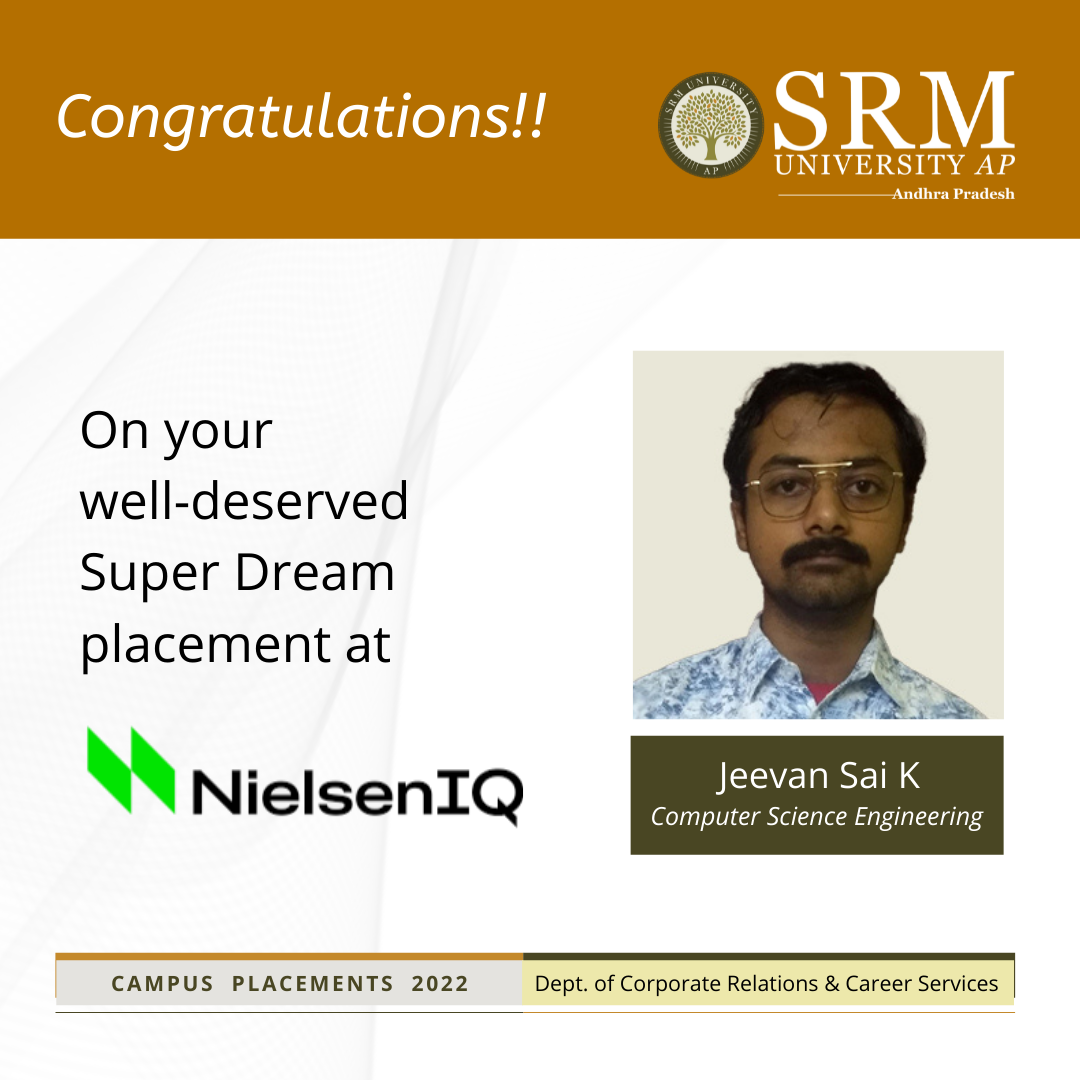 Kanaparthi Jeevan Sai, a B Tech final year student from the Department of Computer Science & Engineering, has secured an exciting job offer with an annual salary package of 11.79 lakhs from NielsenIQ, an industry leader in data points, detailed intelligence, and solutions. He will join the organisation as a full-time Java Software Engineer and work from the Chennai location.
Kanaparthi Jeevan Sai, a B Tech final year student from the Department of Computer Science & Engineering, has secured an exciting job offer with an annual salary package of 11.79 lakhs from NielsenIQ, an industry leader in data points, detailed intelligence, and solutions. He will join the organisation as a full-time Java Software Engineer and work from the Chennai location.
NielsenIQ Consumer LLC is a dream destination for students who specialize in core areas of engineering. For the first three years, the university provided the students with the basics of programming, technical languages, data structures and algorithms. And later in the final year, the placement cell designed student-specific intensive training for all students aspiring for high-paying jobs. The training also covered all the possible model questions for coding rounds and discussed the pattern of previous years.
Jeevan Sai says that the projects need to be presented according to the company and it is important that the resume is well-written and simple. “Group discussions and some of the sessions which helped us to improve our personal and interview abilities and public speaking were arranged by the Department of CR&CS in association with Barclays (also a company). These and were led by industry experts. I thank the placement department for being very active throughout the placement season and clearing our doubts effectively, “Jeevan Sai stated.
- Published in CR&CS, CR&CS NEWS, CSE NEWS, Departmental News, News, Students Achievements
Dr Balaga Mohana Rao receives Best PhD Thesis award from IIT Bombay
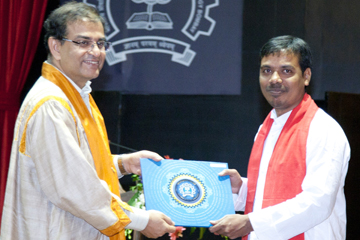 Dr Balaga Mohana Rao, Assistant Professor from the Department of Economics has been awarded the best PhD thesis award in the 59th IIT Bombay convocation held on August 07, 2021. The thesis titled The Early Warnings of the Impending Currency Crises and the Ensuing Macroeconomic Costs aims to develop an Early Warning System to identify the Currency Crises that would help in preventing an impending crisis and also in mitigating the devastating aftermath effects if that occurred.
Dr Balaga Mohana Rao, Assistant Professor from the Department of Economics has been awarded the best PhD thesis award in the 59th IIT Bombay convocation held on August 07, 2021. The thesis titled The Early Warnings of the Impending Currency Crises and the Ensuing Macroeconomic Costs aims to develop an Early Warning System to identify the Currency Crises that would help in preventing an impending crisis and also in mitigating the devastating aftermath effects if that occurred.
The financial crises have enthused a huge theoretical and empirical debate in current times due to their recurrent nature in the history of economics. To highlight the importance of an economic crisis among various sections, Kaminsky et al. (1998) quote Kindleberger (1978) saying that academics are interested in a crisis as they have had a history of fascination for the crises, policymakers are interested because they want to prevent the crisis, and financial market participants are interested as they can make money out of it. The financial crises can be divided into two broad categories—currency and sudden stop crises, and debt and banking crises. The currency crises have not only swept away Argentina (2001), Brazil (1998–1999), Latin America (the 1980s), Russia (1998), Southeast Asia (1997) and UK (1992) (to name a few) but they also have caused serious economic adversities to India and BRICS in the recent past. A currency crisis encompasses one of the following four features or a combination of them owing to a speculative attack—both successful and unsuccessful attacks—on a currency: A sharp depreciation of a currency (possibly followed by devaluation) and/or huge depletion of foreign exchange reserves or an increase in interest rates by the central bank or imposing restrictions on capital flows. In this context, Dr Balaga Mohana Rao’s thesis focuses on developing an early warning system to identify the impending crises, finding the common determinants of currency crises and the aftermath effects on macroeconomic indicators.
“One may wonder why the crisis should be prevented or mitigated. The reason is that a full-blown crisis will not be just confined to the foreign exchange market or some other segment, but it will affect the whole economy” Dr Balaga said. He plans to extend his PhD work on Currency Crises and see it in the context of the International Price System.
- Published in Departmental News, Economics Current Happenings, Economics News, News, Research News
Final year students get placed in ZS Associates
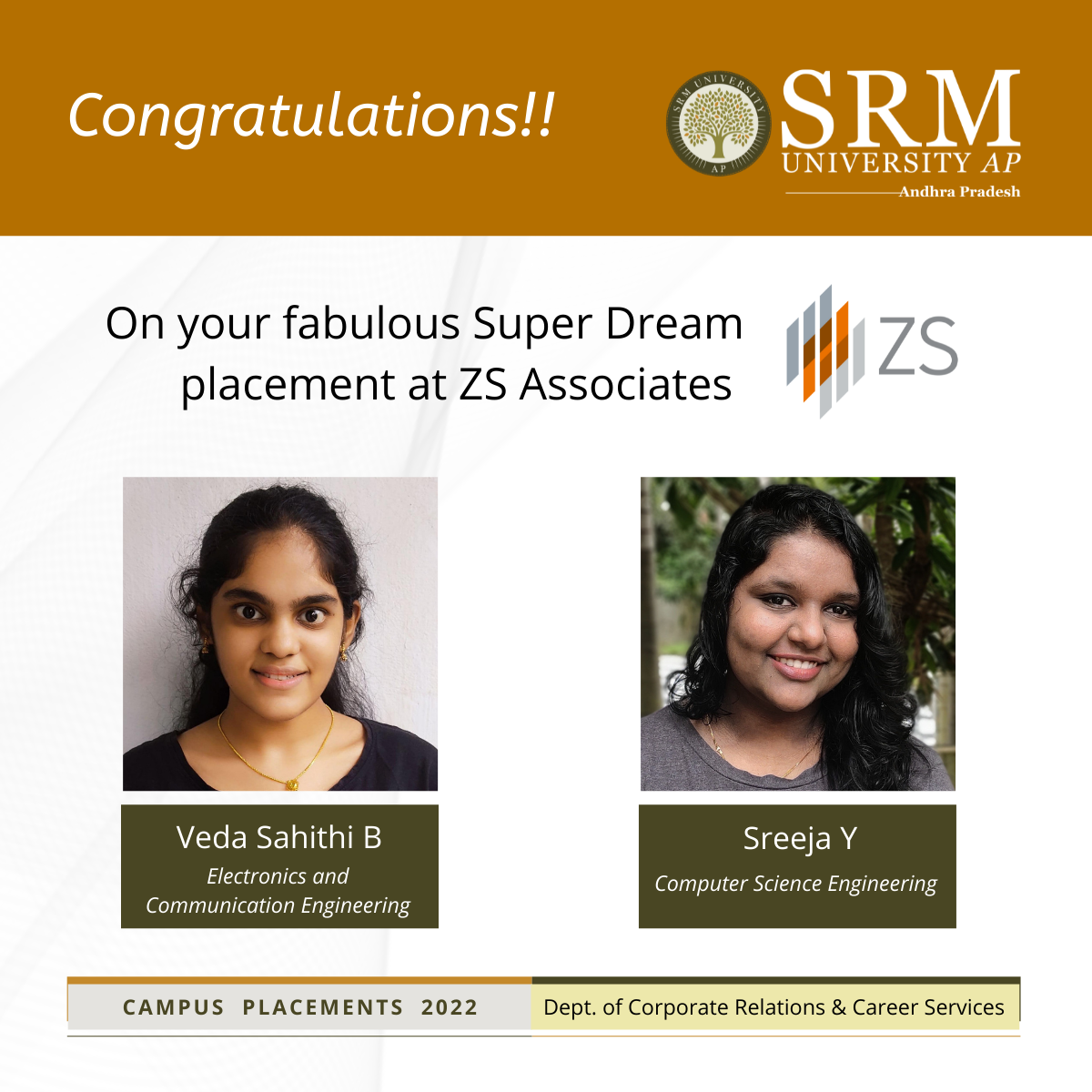 Bandi Veda Sahithi from the Department of Electronics and Communication Engineering, and Sreeja Y from the Department of Computer Science Engineering have been placed at ZS Associates with an exciting CTC of 14.35 LPA.
Bandi Veda Sahithi from the Department of Electronics and Communication Engineering, and Sreeja Y from the Department of Computer Science Engineering have been placed at ZS Associates with an exciting CTC of 14.35 LPA.
Students started their preparation two months prior to the month of placements (approximately April-May and placements started in July). Following a disciplined timetable, and the CCC training given by the university, students have achieved their dream job offers! As Sreeja Y is a Computer Science Engineering Student, she mainly focused on DSA, DBMS, OOPs, OS and Aptitude (sources she used to prepare are Geekofgeeks, YouTube, Hackerrank, Leetcode for coding, W3schools).
The Curriculum for placement provides intensive training for 1 and a half month where the students receive CCC training, Domain training (TIME), and Aptitude training. The CCC Classes helped students understand DSA concepts and apply those concepts in coding. In the Domain training students were taught DSA, CN, OOPs, OS and it helped them further in SQL, DBMS concepts.
Sreeja expresses her gratitude for the guidance, training and sources of knowledge she received from SRM University-AP. “Approximately 75 companies lined up for recruitment in a month. Placement Cell really gives us great and wide opportunities to achieve our goals.” “The placement cell is a wonderful interactive platform that connects various companies with the university, providing abundant opportunities”, added Veda Sahithi.
- Published in CSE NEWS, Departmental News, ECE NEWS, News, Students Achievements
CSE students to transform the future through Accolite Digital
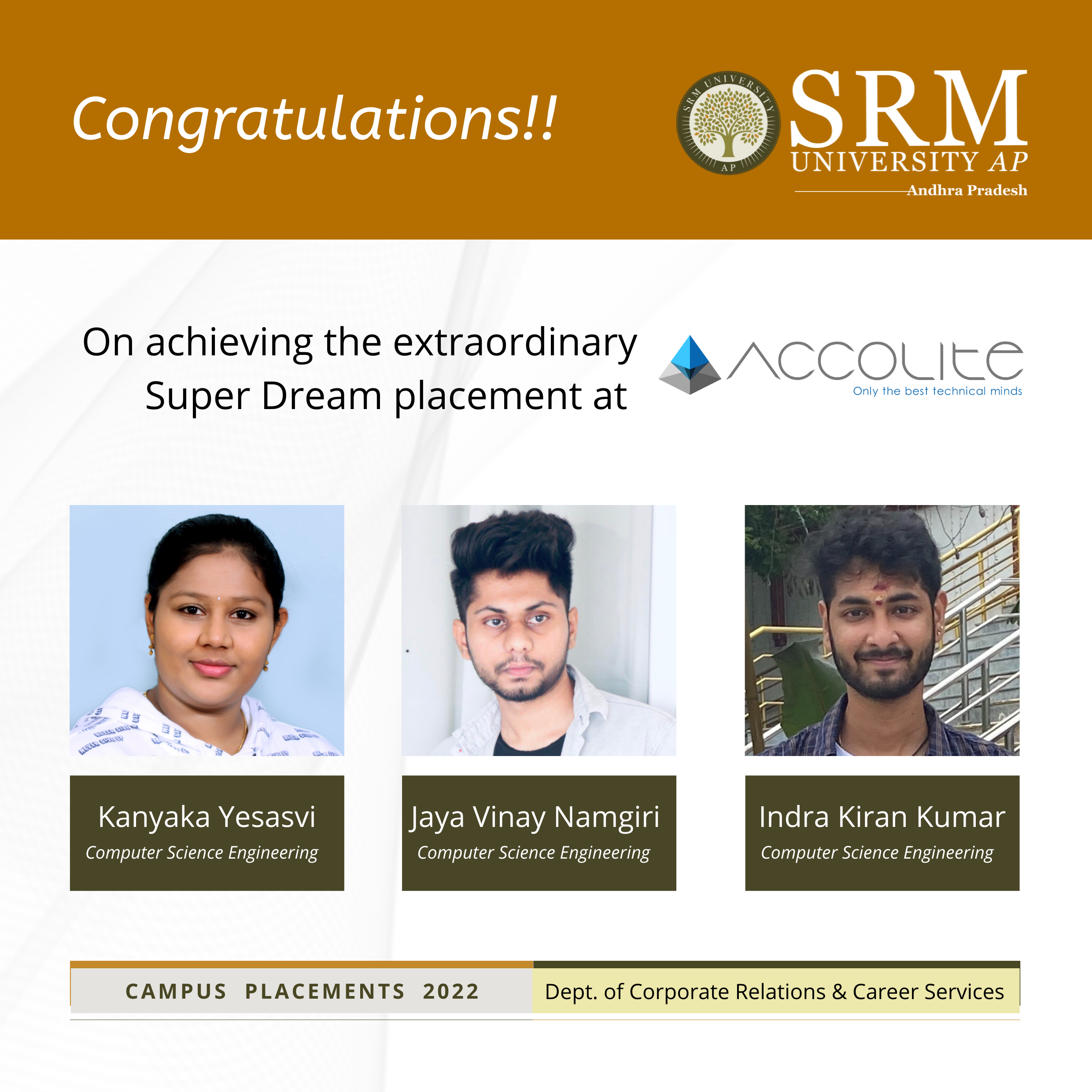 Kanyaka Yesasvi, Jaya Vinay Namgiri, Payeli Indra Kiran Kumar, three vibrant students from the Department of Computer Science Engineering get placed in the reputed digital and product engineering services and solutions company Accolite Digital with an exciting CTC of 11LPA.
Kanyaka Yesasvi, Jaya Vinay Namgiri, Payeli Indra Kiran Kumar, three vibrant students from the Department of Computer Science Engineering get placed in the reputed digital and product engineering services and solutions company Accolite Digital with an exciting CTC of 11LPA.
Accolite Digital, founded in 2007, is a cutting-edge, best-in-class digital transformation services company that has successfully delivered design-driven challenging digital transformation efforts to Fortune 500 companies. They accomplish so by using a network of talented and passionate technologists to simplify their clients’ digital journeys through human-centric design and product innovation Accolite Digital is able to generate compelling business outcomes and when applied to any organisation, this encourages cross-team collaboration to drive transformed digital experiences. Their agile product innovation strategy speeds up design and development while offering a high return on investment.
The curriculum of SRM university-AP consists of training for placements beginning from the second year of graduate studies. It helps students to plan for the recruitment drive beforehand. The curriculum of placement consists of CCC training where students are divided into batches given individual attention on respective domains.
Let’s look into what our students say:
Kanyaka Yesasvi:
When I got to know that I received an offer in Accolite Digital as a software engineer I was overwhelmed with happiness. From July till date more than 80 companies visited us. Every day we are applying to multiple organisations through our placement cell. I am grateful to SRM University for giving me extraordinary opportunities to launch my career.
Payeli Indra Kiran Kumar:
The CR&CS department gives training on all important aspects required for us to crack the placement, like coding classes, contests, mock interviews, mock GD etc. I started preparing for the interviews using the materials provided by CCC. The faculty in my CSE department helped in all possible ways that they can. I suggest to juniors to make use of all the opportunities provided by the university and learn core subjects like DSA, OS, DBMS and CN for cracking super dream placement offers.
Jaya Vinay Namgiri:
Acceleration bootcamp provided by CCC helped me brush up on my coding skills and made me ready to face the companies in the Placement drive 2022. I thank the placement team for providing a helpdesk virtually in spite of this covid situation. That cleared all my doubts and helped me to plan accordingly. I would like to suggest my juniors develop any one project of their interest every year so that at the end of the third year they will be ready to face the recruitment drive.
- Published in CSE NEWS, Departmental News, News, Students Achievements
Resource and network-aware data placement algorithm for periodic workloads in cloud
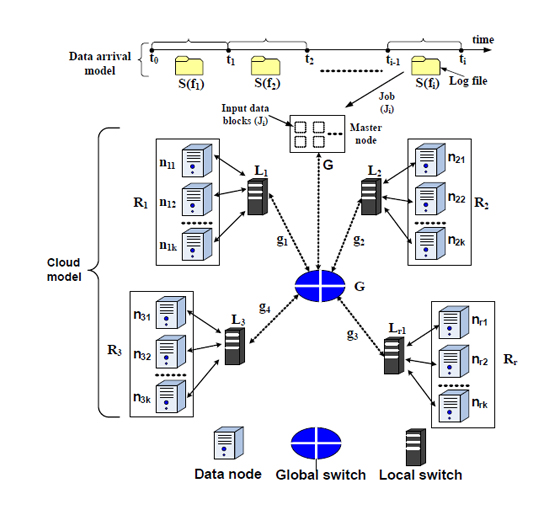 Dr Hirenkumar Thakkar from the Department of Computer Science and Engineering has published a research paper titled “RENDA: Resource and Network-aware Data Placement Algorithm for Periodic Workloads in Cloud” in the journal IEEE Transactions on Parallel and Distributed Systems Vol. 32, No. 12, pp. 2906-2920.
Dr Hirenkumar Thakkar from the Department of Computer Science and Engineering has published a research paper titled “RENDA: Resource and Network-aware Data Placement Algorithm for Periodic Workloads in Cloud” in the journal IEEE Transactions on Parallel and Distributed Systems Vol. 32, No. 12, pp. 2906-2920.
Each year, tech giants are spending millions of dollars to purchase the resources to store the data. However, efficient data placement is a critical issue for companies that experience several terabytes of data generation on daily basis. With such speed of data generation, it is the need of the hour to come up with a strategy for an efficient storage mechanism. This research investigates the data placement problems in cloud data centres and assists several tech giants such as Google, Facebook etc., to manage the cloud resource properly.
This research benefits society with a lower cost of cloud subscriptions, as tech giants are able to save several thousands of dollars by means of an efficient storage mechanism. This ultimately enables the tech giants to offer cloud service subscriptions at a reasonable cost.
The study was carried out in collaborations with Artificial Intelligence and Big Data Computing Lab (ABC Lab), Chang Gung University, Taiwan with Prof. Prasan Kumar Sahoo and in collaboration with Prof. Bharadwaj Veeravalli from the National University of Singapore. In addition to the current collaboration, there are several collaborations with the Indian Institute of Technology (IIT-BHU) as well as the University of Tartu, Estonia.
In future, Dr Thakkar is planning to come up with a book on cloud resource management using Nature-inspired learning. In addition to that, there are few projects such as filing two separate patents on Healthcare data analysis and opinion feature mining in collaboration with Chang Gung University, Taiwan, the National University of Singapore, and the University of Tartu, Estonia.
Read the full paper here: https://doi.org/10.1109/TPDS.2021.3080582
- Published in CSE NEWS, Departmental News, News, Research News
Dr Varaprasad Reddy joins orientation programme to motivate students
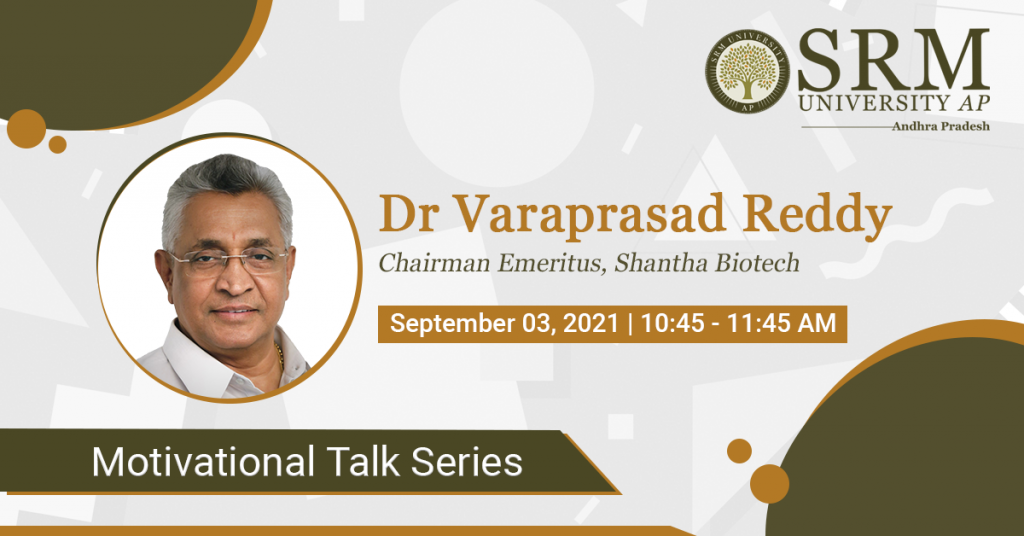 In the next chapter of the Freshmen Orientation Programme-2021, PADMA BHUSHAN Dr Varaprasad Reddy – Founder & Chairman of Shantha Biotechnics Ltd. will be joining us on September 03, 2021, at 10.45 am to meet and greet the new students.
In the next chapter of the Freshmen Orientation Programme-2021, PADMA BHUSHAN Dr Varaprasad Reddy – Founder & Chairman of Shantha Biotechnics Ltd. will be joining us on September 03, 2021, at 10.45 am to meet and greet the new students.
Dr Varaprasad Reddy is a versatile personality who has excelled in various domains of science and technology, entrepreneurship, and industrial development. He is the founder of Shantha Biotechnics, a company that purposes to produce cost-efficient vaccines for the dwellers of India. Shantha Biotechnics developed India’s first ‘indigenously developed’ vaccine against Hepatitis-B, which was made available in the market at a much-reduced cost compared to the imported alternatives.
The credit is due to Dr Varaprasad Reddy and his vision for enabling India to become the leading manufacturer of vaccines. His fervour to contribute to the country won him several accolades, such as the coveted PADMA BHUSHAN award from the government of India and honorary ‘doctorate’ from various universities of repute. The Freshmen 2021 are encouraged to avail the opportunity of attending the session with the illustrious Dr Varaprasad Reddy on September 03, 2021, at 10.45 am, who would propel you towards brilliance and compassion.
- Published in CSE NEWS, Events, Students Affairs Events
First patent granted to SRM University-AP
Title of the Patent: A Process for Preparing Magnesium Foams
Patent applicant: SRM University-AP, Andhra Pradesh
Patent Application number: 202041001715
Date of Filing: 14/01/2020
Date of Publication: 24/01/2020
Date of Grant: 16/08/2021
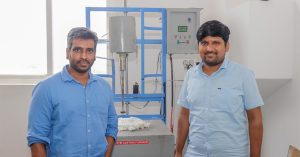 Prof G S Vinod Kumar and his PhD Scholar Mr Dipak Nandkumar Bhosale from the Department of Mechanical Engineering has brought the first granted patent to SRM University-AP. The patent titled “A Process for Preparing Magnesium Foams” is on the novel processing of Magnesium alloy foams via molten metal route. Metal foams are the class of novel ultra-lightweight and high strength materials used for engineering structures. Under the light-alloy category, Magnesium alloys possess greater challenges to foam and the inventors Mr Dipak Bhosale, PhD scholar and Prof Vinod Kumar (PhD supervisor) of Dept. of Mechanical Engineering have come up with a novel process to foam Magnesium alloy effectively. The patent was filed on January 14, 2020, and granted on August 16, 2021. It is indeed commendable that the patent grant is obtained in just 16 months from the date of application.
Prof G S Vinod Kumar and his PhD Scholar Mr Dipak Nandkumar Bhosale from the Department of Mechanical Engineering has brought the first granted patent to SRM University-AP. The patent titled “A Process for Preparing Magnesium Foams” is on the novel processing of Magnesium alloy foams via molten metal route. Metal foams are the class of novel ultra-lightweight and high strength materials used for engineering structures. Under the light-alloy category, Magnesium alloys possess greater challenges to foam and the inventors Mr Dipak Bhosale, PhD scholar and Prof Vinod Kumar (PhD supervisor) of Dept. of Mechanical Engineering have come up with a novel process to foam Magnesium alloy effectively. The patent was filed on January 14, 2020, and granted on August 16, 2021. It is indeed commendable that the patent grant is obtained in just 16 months from the date of application.
Metal foam is a cellular structure consists of solid metal with gas-filled pores. The pores can be sealed (closed-cell foam) or interconnected (open-cell foam). The present patent relates to a process for the preparation of closed-cell Magnesium foams using dolomite [CaMg (CO3)2] as a blowing agent (gas source), through a liquid metal route. The inventors have demonstrated economical and naturally occurring mineral dolomite to be an effective blowing agent for preparing magnesium foams and in-situ formed MgAl2O4 (spinel) particles as the stabilizing agent during stabilization of foams. The Magnesium foams produced by the process of the present disclosure have a good expansion, lower density, uniform pore size distribution and polyhedral pore structure. Through the present process Magnesium foams with 88% porosity 0.20 g/cm3 foam density was obtained. Magnesium foam is an attractive material that exhibits a unique combination of mechanical, physical, thermal, electrical and acoustic properties. It has high strength to weight ratio, good compressive strength and high energy/shock/vibration/sound absorption efficiency. Owing to these properties the magnesium foam finds potential in lightweight structural applications, sound-absorbing, energy and vibration and shock damping application.
$1750 cash prize awarded to Team Hexagon at the International Hackathon 2021
Yuvraj Tankala and Joseph K Paul from the Department of Computer Science and Engineering, SRM University-AP has successfully bagged a cash prize of $1750 at the Datastax Hackathon held from Dec 2020 to Feb 2021. The duo formed the “Team Hexagon” and demonstrated their full-stack AI monitored online classroom and examination portal project at the international competition conducted by Datastax. It powered the innovative data apps to the Home Depot, T-Mobile, Intuit, and half of the Fortune 100 companies.
Rakuten India Enterprise Private Limited conducted this 24-hour challenge competition amongst 7000+ participants. Based on three rounds- 1) Ideation Phase 2) Build Phase 3) Finals-winners were decided. Each team comprised of one to four members and they were allotted various themes such as Mobile and Web Development, Web Analytics, Platform Development and Backend Engineering, Data Science, Machine Learning and Artificial Intelligence.
While briefing on the project, Team Hexagon elucidated, “We were excited to participate in the competition and immediately started working on the project. After outlining the base of the project, we were assured that it could create a positive impact during this unprecedented time of Covid-19 outbreak. The education system is facing tough times while managing online assessments. We introduced an AI model-based monitoring system for examiners and examinees involved in the evaluation process. The application follows the head and lip movements of the examinee by considering the various parameters. It tracks the head movement in two axes (up-down and right-left) and warns the examinee to concentrate on the screen. In a similar way, it follows the lip movement and alerts the examiner when found any abnormal movements in between assessment”.
Yuvraj and Joseph presented their project before Technology Business Incubator’s panel, which was shortlisted from 34 other proposals. Under this programme, they went under rigorous training for 12 months and received the felicitation of industry support, seed funding, innovation fund support, industry connectivity with the key players in the market. Winning over the competitive challenges has given the duo high confidence to work on multiple projects and plan to lead off a venture after the completion of academic years.
- Published in CSE NEWS, Departmental News, News
CRIDAP appoints Dr Ghanshyam Pandey as an expert for agriculture
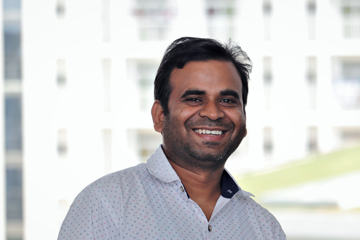 Dr Ghanshyam Pandey, Assistant Professor of Economics, SRM University – AP has been appointed as an expert for agriculture, rural development, livelihood issues, and climate change and agriculture by The Centre of Integrated Rural Development for Asia and Pacific (CRIDAP). CRIDAP is an intergovernmental and autonomous organization and has 15 member countries. The member countries are Afghanistan, Bangladesh, Fiji, India, Indonesia, Iran, Lao PDR, Malaysia, Myanmar, Nepal, Pakistan, Philippines, Sri Lanka, Thailand, and Vietnam. His tenure of appointment will be up to 2024.
Dr Ghanshyam Pandey, Assistant Professor of Economics, SRM University – AP has been appointed as an expert for agriculture, rural development, livelihood issues, and climate change and agriculture by The Centre of Integrated Rural Development for Asia and Pacific (CRIDAP). CRIDAP is an intergovernmental and autonomous organization and has 15 member countries. The member countries are Afghanistan, Bangladesh, Fiji, India, Indonesia, Iran, Lao PDR, Malaysia, Myanmar, Nepal, Pakistan, Philippines, Sri Lanka, Thailand, and Vietnam. His tenure of appointment will be up to 2024.
Dr Ghanshyam Pandey’s role in the organisation:
- CIRDAP resource person to participate in project proposal development and consultancy.
- CIRDAP resource person for flagship training courses.
- Reviewer of Asia-Pacific Journal on Rural Development (APJORD).
- Part of CIRDAP Think Tank for knowledge sharing and solutions to IRD and PA.
- To expand CIRDAP Think Tank Networks.
- To advise on refining CIRDAP Strategic Plan 2020-2024.
About the organisation:
The Centre on Integrated Rural Development for Asia and the Pacific (CIRDAP) is a regional, intergovernmental and autonomous organisation. It was established on 6 July 1979 at the initiative of the countries of the Asia-Pacific region and the Food and Agriculture Organization (FAO) of the United Nations with support from several other UN bodies and donors. The Centre came into being to meet the felt needs of the developing countries at that time as an institution for promoting integrated rural development in the region. From the original six members, CIRDAP has now grown up as a Centre of 15 member countries. The member countries are Afghanistan, Bangladesh (Host State), Fiji, India, Indonesia, Iran, Lao PDR, Malaysia, Myanmar, Nepal, Pakistan, Philippines, Sri Lanka, Thailand and Vietnam. Operating through designated contact ministries and link institutions in member countries, CIRDAP promotes regional cooperation. It plays a supplementary and reinforcing role in supporting and furthering the effectiveness of integrated rural development programmes in Asia and the Pacific.
- Published in Departmental News, Economics Current Happenings, Economics News, News, Research News
Cost-effective electro-catalyst for oxygen reduction reaction
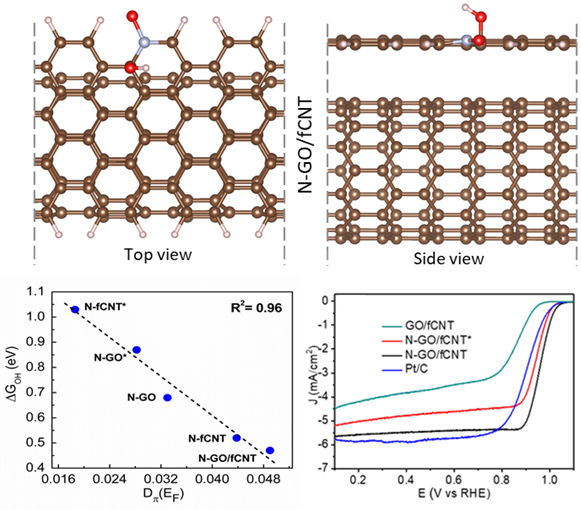 A research paper titled “Nitrogen doping derived bridging of Graphene and Carbon Nanotube composite for oxygen electroreduction” has been published by Prof Ranjit Thapa, Professor of Physics, SRM University – AP, as a co-author, in International Journal of Energy Research, having Impact Factor of 5.164.
A research paper titled “Nitrogen doping derived bridging of Graphene and Carbon Nanotube composite for oxygen electroreduction” has been published by Prof Ranjit Thapa, Professor of Physics, SRM University – AP, as a co-author, in International Journal of Energy Research, having Impact Factor of 5.164.
In this work, the research group investigated the origin of high catalytic activity of oxidic-N configuration in nitrogen-doped CNT and graphene heterostructure using density functional theory (DFT). We have plotted the free energy profile of the oxygen reduction reaction (ORR) to estimate the thermodynamic overpotential and catalytic performance of the respective active sites. The overpotential is related to the quantifying parameter ∆GOH (with R2 = 0.98) and the π electron density at the Fermi level, defined as an electronic descriptor, which is highly correlated with the ∆GOH with R2 value 0.96. For various N doped configurations, we correlated the ∆GOH values with π electron density at the Fermi level and found that the carbon site adjacent to the oxide-N configuration is a more prominent site for ORR. Further, we show that the oxidic-N configuration in the heterostructure of graphene and CNT is the ideal configuration, which gives a lower overpotential of 0.54 eV for ORR on adjacent carbon sites. Therefore, the charge transfer occurs from underneath CNT to graphene and increases the value of π electron density at the Fermi level which leads to the higher catalytic performance of the active site.
In the early 20th century, fuel cells were invented and their global impact has not reached up to its regular commercialization when compared with battery technology. The fuel cell device could be a powerful technique to generate electricity for large energy demand without greenhouse gas emissions. However, other major hurdles in the commercialization of fuel cell devices are the cost of platinum (as a catalyst), its poisoning and stability. Recently, carbon-based materials such as graphene, carbon nanotubes and activated carbon have been evolved as metal-free low-cost catalysts due to their (i) high abundance/yield (ii) reactivity towards oxygen just by introducing impurities like heteroatoms or other metals. However, identifying an efficient design principle to search optimal doping configurations in various carbon systems is a grand challenge for researchers.
This work is done in collaboration with Research Institute, SRM Institute of Science & Technology, Kattankulathur-603203, Chennai (India).
In future, the study aims to propose the effective design principle for various doped carbon systems as a catalyst to identify the optimal active sites and configurations for ORR. The role of π orbital in carbon systems such as graphene, graphene nanoribbons, carbon nanotube, etc is very important and can be a general electronic descriptor to define catalytic activity. Also, π electron descriptors and machine learning algorithms based combined approach can boost the search for ideal carbon catalyst for ORR with low DFT cost.
Read the full paper here: https://doi.org/10.1002/er.7179
- Published in Departmental News, News, Physics News, Research News

